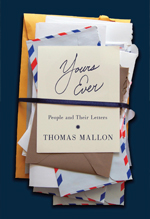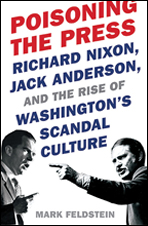Man of Letters
 Written communication is in a state of constant reinvention, so it's easy today to bemoan the romantic notions of forms
gone by.
Written communication is in a state of constant reinvention, so it's easy today to bemoan the romantic notions of forms
gone by.
But English professor Thomas Mallon takes a higher road in his new book, Yours Ever: People and Their Letters (Pantheon Books, 2009). The book is far less about ink-on-paper than it is about our need for correspondence, about the craftsmanship of language, about the nuances of relationships—deeply rooted factors that could just as well be studied in cave drawings or e-mails or Facebook updates.
With grace and wit, Dr. Mallon escorts readers across time and emotional turbulence, sharing the guilty pleasure of spying on correspondence between mothers and sons, fathers and daughters, sinners and confidantes, but also toxic letters that were never sent, suicide notes, and hate mail, among other genres.
The book, due in paperback in December, is stuffed with interesting tidbits (Thomas Jefferson, privately sullen during his presidency, writes that the office "brings nothing but unceasing drudgery & daily loss of friends"); heart-breaking prose (after the death of a lover and the loss of all else in the Nazi bombing of London, novelist Rose Macaulay writes: "I am bookless, homeless, sans everything but my eyes to weep with"); and literary venom (humorist S.J. Perelman writes that Hollywood is a "misbegotten flea-pit" filled with a "flock of beetle-brained windsuckers with necks hinged so they can yes Darryl Zanuck").
There even are letters about letter-writing. After French writer Marie de Rabutin Chantal, aka Madame de Sévigné, prods her daughter, Françoise, on what is expected in a letter (namely: details, details, details), Madame de Sévigné exults when she finally gets it: "I have never seen such a brilliant letter as your last," she writes her daughter in 1676. "I nearly sent it back to you to give you the pleasure of reading it."
A Wild 'Merry-Go-Round'
 In 1972, operatives of then-President Richard Nixon faced a difficult dilemma: how best to murder investigative reporter Jack Anderson. Should it be a poison pill slipped into his medicine cabinet (a game of "aspirin roulette")? Or LSD brushed onto his steering wheel? Or maybe a strategic car collision? In the end, the men agreed to drop the theatrics and simply stab Mr. Anderson or break his neck. It would look like just another D.C. homicide.
In 1972, operatives of then-President Richard Nixon faced a difficult dilemma: how best to murder investigative reporter Jack Anderson. Should it be a poison pill slipped into his medicine cabinet (a game of "aspirin roulette")? Or LSD brushed onto his steering wheel? Or maybe a strategic car collision? In the end, the men agreed to drop the theatrics and simply stab Mr. Anderson or break his neck. It would look like just another D.C. homicide.
The plot never materialized, but it didn't have to; its mere existence is shocking enough. How did a relationship between a president and columnist come to this?
The story unfolds with the grip of a thriller in Mark Feldstein's Poisoning the Press: Richard Nixon, Jack Anderson, and the Rise of Washington's Scandal Culture (Farrar, Straus and Giroux, 2010). Dr. Feldstein, an associate professor of media and public affairs (and one-time intern for Mr. Anderson), artfully reconstructs, blow-by-blow, the 25-year feud between Mr. Nixon and Mr. Anderson that shook reputations and whole corridors of power in the nation's capital.
Mr. Anderson's syndicated gotcha column, "Washington Merry-Go-Round"—eventually the longest-running and most popular column in the country—had been an incessant irritant to Mr. Nixon in Congress and, later, the White House, churning out scoops like a Baskin-Robbins.
He blazed a trail for the budding field of investigative journalism, and won a Pulitzer Prize, but he was a tarnished hero at best.
Mr. Anderson embraced a mentality of shoot-and-ask-questions-later—"if at all," writes Dr. Feldstein—and wasn't above the use of coercion, innuendo, spy tactics, or strange bedfellows to generate an aura of fear around his column.
"Few reach the political pinnacles without selling what they do not own and promising what is not theirs to give," Mr. Anderson once wrote. But, Dr. Feldstein counters, "this was as true for journalists like Jack Anderson as it was for politicians like Richard Nixon."
Both men spilled some poison, Dr. Feldstein writes, and helped pollute modern practices of politics and the media. And though the principals are long gone, the merry-go-round keeps spinning.
Food for Thought
 If you're a meat-lover, or an egg fanatic (or a dairy farmer, for that matter), The Get Healthy, Go Vegan Cookbook (Da Capo Press, 2010), by adjunct associate professor of medicine Neal Barnard and nutritionist Robyn Webb, may at first cause some emotional distress. Or at least some eye-rolling.
If you're a meat-lover, or an egg fanatic (or a dairy farmer, for that matter), The Get Healthy, Go Vegan Cookbook (Da Capo Press, 2010), by adjunct associate professor of medicine Neal Barnard and nutritionist Robyn Webb, may at first cause some emotional distress. Or at least some eye-rolling.
But this is much more than a cookbook—it's a crash-course in nutrition. And even if Dr. Barnard, MD '80, can seem a smidge overzealous about the ills of animal-derived foods and the divine goodness of fruits, veggies, and legumes, he and Ms. Webb do build a compelling case. Perusing the introduction, even the skeptical reader will feel an urge to sneak a peek at the recipes … y'know, just out of curiosity.
From the very first line—"This book holds the culinary secrets to lifelong health"—there are big promises made for the vegan way of life: weight loss and better control over blood pressure, cholesterol, diabetes, digestive trouble, and even cancer. The authors build a sturdy foundation for these claims with research data (and even provide a citation list), personal accounts of reformed omnivores, and easy-to-digest morsels of dietary science.
More than a hundred recipes follow, using familiar ingredients as well as some that might be new to non-vegans, like soybean-derived tofu and tempeh that are used for re-imagining egg and meat dishes.
Thankfully, the case laid out by the authors is informative and inviting; it allows readers to stay open-minded to sampling new flavors and healthier substitutions—even if they're less inclined to give up their favorite foods whole-hog.
—Danny Freedman
